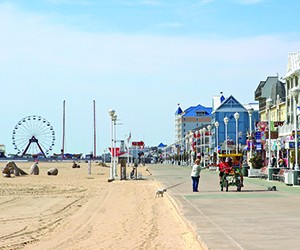SMERF events are short on glamour and glitz. They seldom make headlines. But for destinations and sales teams that take the time to learn the social, military, education, religious and fraternal market, SMERF is business they can bank on. Events return year after year, often on the same date, and sometimes for years.
“We have groups that have been coming here for decades,” said Larry Noccolino, executive director of the Roland E. Powell Convention Center in Ocean City, Md. “We have dance and cheer groups that have been coming since the 1970s. If you talk about groups like Church of God or Youth for Christ, we are on our third generation. SMERF can be an extremely valuable market year in and year out, in boom times and in recession.”
The convention center is open for business 47 weekends a year, he continued. SMERF groups fill 20 of those 47 weekends. In a small beach town with just over 9,500 hotel rooms, a single cheerleading event can bring 16,000 attendees in the off-season.
SMERF is also a major piece of the pie in Sacramento, Calif.
“We have been very successful with the religious market,” said Mike Testa, chief operating officer of Visit Sacramento. “We have not only been successful in attracting those meetings but in getting them back again. Fraternal clubs also find Sacramento attractive and bring everything from a couple of hundred to citywides of 5,000. And unlike first-tier cities, when you are a citywide in Sacramento you are the citywide in Sacramento. That kind of special attention allows us to build relationships that bring repeat business.”
Filling the Gaps
For many destinations, SMERF groups are a profitable niche to fill around higherprofile commercial and association group business and summer holiday traffic.
“Our main season is Memorial Day to Labor Day,” said Audrey Bialas, director of sales for the Hershey Harrisburg Regional Visitors Bureau in Pennsylvania. “Anything in the fall, winter and early spring is important. We are a third-tier city size-wise, but we have 8,000 hotel rooms to meet that summer demand. If you have the flexibility to shift your event outside that primary season, we are a buyer’s market. That’s how important SMERF is in our overall business plan.”
The variety of the SMERF market can be a logistical bonus for convention bureaus. Groups range from 20 to more than 10,000. That gives CVBs an opportunity to work with a wide range of members, not just the biggest convention hotels.
Religious groups can be particularly useful. National conventions may top 10,000 but most are small, with 500 attendees and fewer, said Bob Murdock, director of national accounts for the Connecticut Convention and Sports Bureau in Hartford. That lets the bureau work with a single property that can handle the entire event.
“SMERF groups in general like to keep everyone at a single property because it helps them build the feeling of togetherness. Religious groups especially like to keep their group together. And they tend to have the flexibility to meet on weekends, the low point for properties with significant business travel. It can be even better if their focus is a particular religious event. We have hotels that maintain kosher kitchens that are at 100 percent every Passover no matter what the season or what else is happening. SMERF is money in the bank.”
With the right approach, SMERF can become a perpetual bank account. The Virginia Beach Convention and Visitors Bureau (VBCVB) views repeat business and multiyear contracts as a bare minimum. What they really want is family exposure to the destination that translates into repeat visits over lifetimes and generations.
“If we have someone come for a cheer and dance event, we aim to appeal to the participants, the organizers and the parents,” explained Todd A. Bertka, vice president of convention sales and marketing for the VBCVB. “We want the adults to have such a good time that they come back on their own time for vacation. And we want the participants to have such a good time that when they grow up and want to come to the beach, this is the first place they think of. We are driving distance for a third of the population of the entire country. SMERF is a hugely important market for us.”
Pick and Choose Your Destination
Almost any mid-tier destination can tap the SMERF market, but location helps. The most successful SMERF locales tend to be near major markets. San Francisco will never be a reliable SMERF market, but Sacramento, 100 miles away, is. Few SMERF groups can afford the glitzy palaces that line Las Vegas Boulevard, but Henderson might work.
Seasonality is another factor. Destinations with strong summer leisure traffic such as Ocean City, Virginia Beach and Hershey-Harrisburg can be desperate to make SMERF deals in the off season.
For other destinations, time of week is more important than season. The National Conference Center in Leesburg, Va., does about 40,000 room nights a year in SMERF business, nearly all of it on weekends.
“We are 30 miles from Washington, D.C., so we have the D.C. feeling, except we are on a quiet 65-acre campus, walking distance to the Potomac River, and totally peaceful,” said Chuck Ocheltree, chief marketing officer for The National Conference Center. “We are a dedicated conference center. During the week, that is mostly corporate and government training. We have much more attractive pricing on weekends and much more flexibility with our meeting space utilization. SMERF events are all about belonging and strengthening their sense of community. We give them pricing that encourages everyone to stay on the campus and build that feeling of togetherness.”






